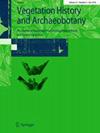The first extensive study of an Imperial Roman Garden in the city of Rome: the Horti Lamiani
IF 1.9
2区 地球科学
Q1 PALEONTOLOGY
引用次数: 0
Abstract
Abstract This paper presents the first systematic results of integrated plant macrofossil and pollen analyses from the Horti Lamiani (1st-3rd century ce ), an aristocratic residence with a luxury garden which was established on the Esquilino (Esquiline Hill) in Rome during the time of the first Emperor, Caesar Augustus (27 bce -14 ce ) and later became one of the most famous Imperial gardens around the ancient city. Different types of plant remains such as charcoal, seeds and fruits and pollen were recovered from pits and pots in the garden and reflect the presence of plants there. There seem to have been ornamental shrubs which were probably grown as decorative modelled hedges and/or isolated bushes, as well as cultivated trees. Several ornamental flowering plants grew in pots. Although this archaeobotanical assemblage could represent some patches of wild vegetation still growing in the study area at the time of the Imperial garden, it is likely that most of the identified plants were intentionally planted and organised to create a glimpse of the past wild landscape of Rome. They have special characteristics, such as bearing coloured flowers or fruits and offering shade, that made them suitable for embellishing a magnificent garden. Moreover this reflects the Roman desire to control nature, testified by the expansion of luxury gardens during the Imperial period and the spread of decorative horticultural techniques, like the miniaturisation of trees and shaping of trees and shrubs by topiary.第一次对罗马帝国花园的广泛研究:Horti Lamiani
摘要:本文首次系统地分析了Horti Lamiani(公元1 -3世纪)的植物宏观化石和花粉。Horti Lamiani是罗马第一位皇帝凯撒奥古斯都(公元前27 -14年)时期在埃斯奎利诺山上建造的贵族住宅,拥有一座豪华花园,后来成为古城周围最著名的皇家花园之一。从花园的坑和花盆中发现了不同类型的植物遗骸,如木炭、种子、果实和花粉,反映了那里植物的存在。这里似乎有一些观赏灌木,它们可能是作为装饰性的树篱和/或孤立的灌木种植的,也有种植的树木。几种观赏花植物在花盆里生长。虽然这个考古植物组合可以代表在皇家花园时代研究区域仍然生长的一些野生植被斑块,但很可能大多数已确定的植物都是有意种植和组织的,以创造罗马过去野生景观的一瞥。它们有特殊的特点,如开花或结彩,遮荫,使它们适合点缀一个宏伟的花园。此外,这反映了罗马人控制自然的愿望,帝国时期豪华花园的扩张和装饰园艺技术的传播证明了这一点,比如树木的小型化和树木和灌木的修剪。
本文章由计算机程序翻译,如有差异,请以英文原文为准。
求助全文
约1分钟内获得全文
求助全文
来源期刊
CiteScore
5.30
自引率
8.00%
发文量
32
审稿时长
>12 weeks
期刊介绍:
Vegetation History and Archaeobotany publishes research papers, review articles and short contributions of high quality from Europe, the Americas and other parts of the world. It covers the entire field of vegetation history – mainly the development of flora and vegetation during the Holocene (but also from the Pleistocene), and including related subjects such as palaeoecology. Of special interest is the human impact upon the natural environment in prehistoric and medieval times; this is reflected in pollen diagrams as well as in plant macroremains from archaeological contexts.

 求助内容:
求助内容: 应助结果提醒方式:
应助结果提醒方式:


